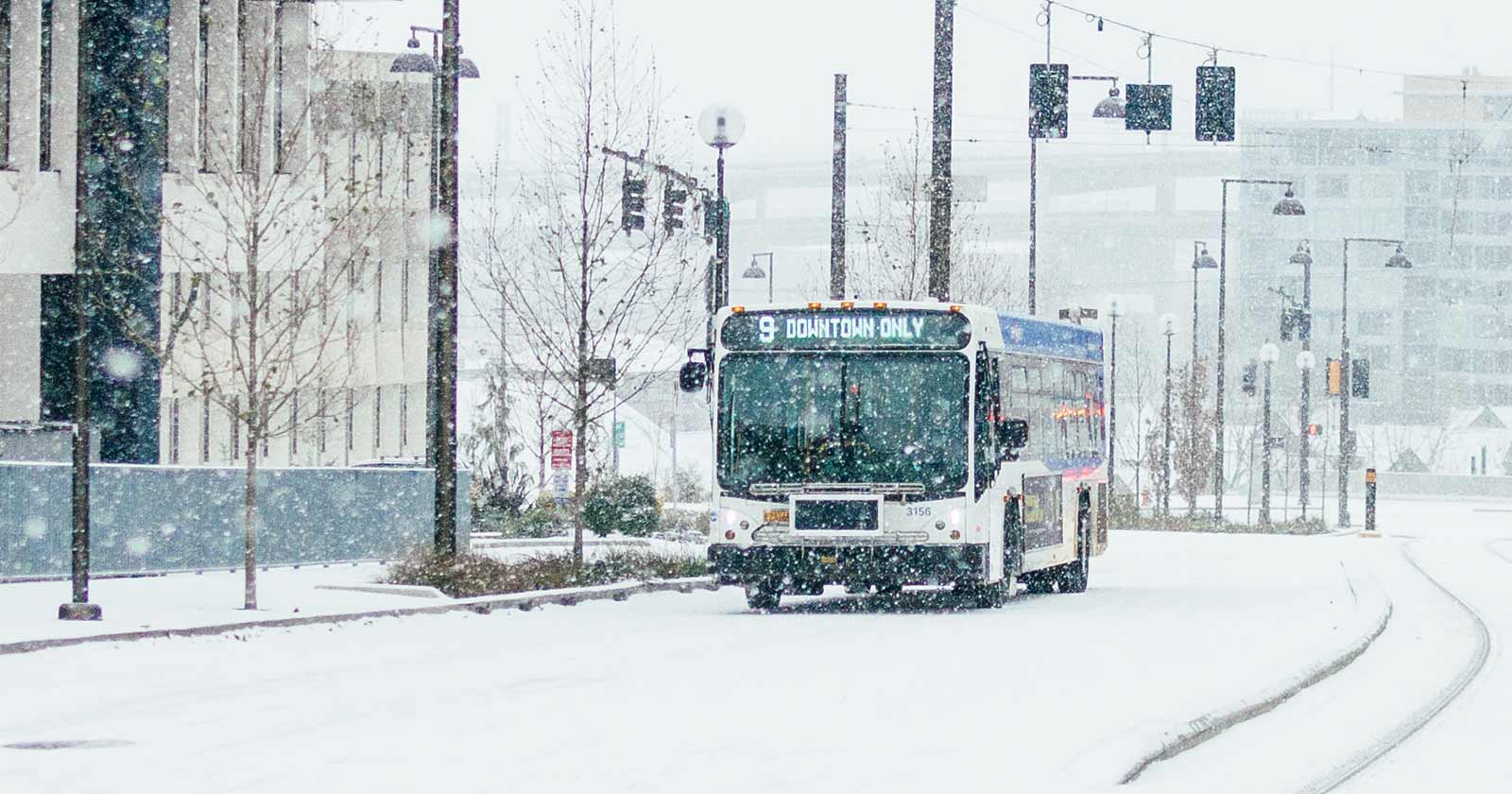
Winter Weather Tips
If you’re riding during snowy or icy weather, here’s what you need to know.
Where to get service information
Conditions can change quickly. Before you leave, get the latest updates on detours, delays and cancellations:
-

Web
Check Service Alerts on trimet.org.
-

Email
Sign up to get email or SMS updates about snow/ice service.
-

X (Twitter)
Follow @trimetalerts on X for the most current alerts about snow/ice service.
Rider assistance is available daily from 7:30 a.m. to 5:30 p.m. on X at @trimethelp.
-

Chat
Chat live with TriMet Customer Service, 7:30 a.m. to 5:30 p.m. daily.
A note about real-time arrival information
Our online Trip Planner and TransitTracker real-time arrivals assume that regular service is in effect. During snow and ice, be sure to look for Service Alerts on your trip itinerary and check for alerts again before you leave.
In snowy or icy conditions, buses and trains get so far off their normal schedule or route that TransitTracker™ (our real-time arrival information system) can’t predict arrivals accurately. Instead of an arrival countdown, we’ll tell how far away the next vehicle is using “miles away,” which will give you a better sense of when it will arrive. We’ll also send out a Service Alert with details about service on that line.
Bus riders:
Be prepared for detours
When the snow starts falling
Buses will follow their normal routes as long as the streets are safe for travel. We work with city, county and state road crews to help make sure bus routes get plowed first. We’ll chain buses as necessary, especially those that travel at higher elevations.
Significant snow/ice conditions
As snow or ice accumulates, some lines may be canceled due to road conditions. Others will be detoured to avoid parts of the route that are not safe to drive on.
Routes subject to cancellation
- 18-Hillside
- 26-Thurman/NW 18th
- 53-Arctic/Allen
- 55-Hamilton
- 63-Washington Park/Arlington Heights
- 84-Powell Valley/Orient Dr
- 153-Stafford/Salamo
- 156-Mather Rd
Severe weather service plan
If the weather gets really bad, and stays bad, we’ll limit service to a select group of bus lines operating on plowed streets, so that we can serve the most riders.
Following are the bus lines we plan to operate during severe snow/ice conditions. Other bus lines may be canceled if buses can't run due to impacts from snow and ice. Check Service Alerts on trimet.org.
Service during severe snow/ice conditions
Note: Buses won’t be on schedule, but they should be running at regular intervals as road conditions allow.
- FX2-Division
- 4-Fessenden
- 6-Martin Luther King Jr Blvd
- 8-Jackson Park/NE 15th
- 9-Powell Blvd
- 12-Barbur/Sandy Blvd
- 14-Hawthorne
- 15-Belmont/NW 23rd
- 17-Holgate/Broadway
- 20-Burnside/Stark
- 33-McLoughlin/King Rd
- 48-Cornell
- 54-Beaverton-Hillsdale Hwy
- 57-TV Hwy/Forest Grove
- 72-Killingsworth/82nd Ave
- 73-122nd Ave
- 75-Cesar Chavez/Lombard
- 76-Hall/Greenburg
- 87-Airport Way/181st
Boarding buses in snow and ice
- If your bus stop is in the middle of a hill, walk to the bottom or top of the hill where the operator can safely stop.
- Stand back from the curb until the bus comes to a complete stop. Buses can slide sideways in slippery conditions.
- When roads are snowy or icy, buses will not pull all the way over to the curb to avoid getting stuck. Be careful when walking between the bus and the curb. Accommodations will be made to assist riders with mobility devices.
MAX riders:
Plan for possible transfers
If you’re riding MAX during wintry weather, plan extra time. Your train may be delayed and you may have to make extra transfers.
MAX typically runs well in snow, though it’s not uncommon for trains to be delayed because autos are stuck blocking the tracks. Ice and freezing rain can cause problems if it begins to build up on the overhead wires.
To keep the overhead wires clear of ice buildup and keep trains running close to scheduled times, we may need to shorten some lines and add more trains in some sections. If this happens, you may need to board a different line than normal and/or make additional transfers. In some situations, you may need to use a shuttle bus between stations.
Here are some adjustments we may need to make:
- MAX Green Line may shorten and run only between Clackamas Town Center and Gateway Transit Center. Use other MAX or bus lines between Gateway and Downtown Portland.
- MAX Orange and Yellow lines may need to split, with the Yellow Line only running between Expo Center and Interstate/Rose Quarter and the Orange Line only running between Union Station and SE Park Ave. Use other MAX or bus lines, or shuttle buses, to cross the river.
- MAX Red Line may shorten and only run between Portland International Airport and Gateway Transit Center. Use other MAX lines between Gateway, Downtown Portland and Beaverton.
Bundle up and expect delays
Road conditions affect all traffic, so buses may experience significant delays. Chained buses can’t travel more than 25 mph. They won’t be on schedule, but we aim to keep them moving and doing it safely.
MAX Light Rail, WES Commuter Rail and Portland Streetcar will operate normally unless there is a problem with the tracks, switches or the overhead wires. To be safe, always dress warmly, plan extra time and make sure you’re visible when it’s dark out.
Note: To help promote airflow and prevent the spread of airborne diseases, some windows on buses may be open even during cold weather. We’ll keep the heat blasting but be sure to bundle up as well.
Shuttle buses may serve MAX, WES and Streetcar stations
If we expect MAX, WES or Streetcar service to be interrupted for a significant period of time, we’ll make every effort to send out shuttle buses to carry riders between stations. That means you’ll go to the station like you normally would, but you’ll board a shuttle bus instead of a train.
The bus will pull up near the station, with a sign that says “Shuttle.” Unless otherwise indicated, the bus will stop at all the stations along the route. If unsafe conditions prevent the shuttle bus from serving a particular station, the bus will stop nearby instead. In extreme conditions, we may not be able to send out shuttle buses; if this happens, we will let you know as soon as possible.
